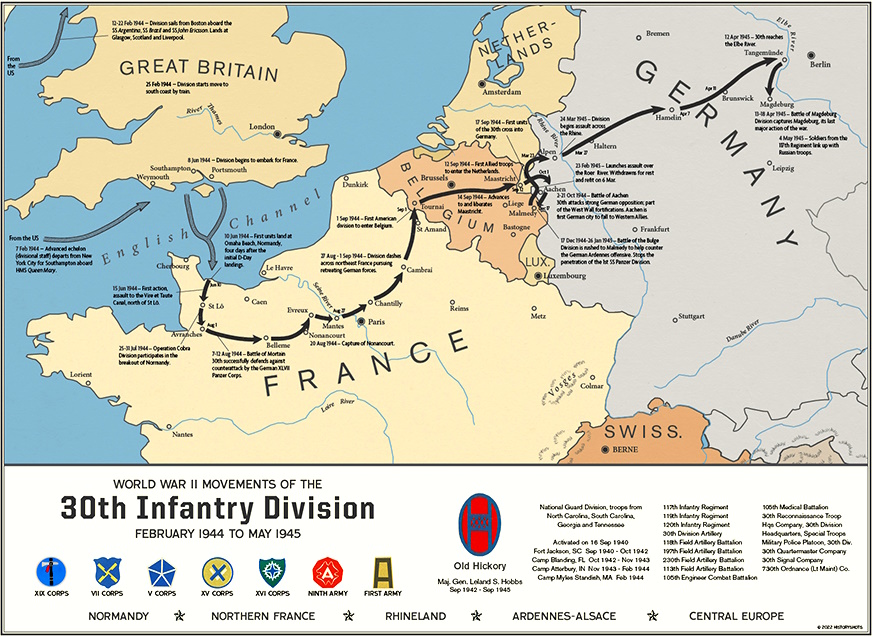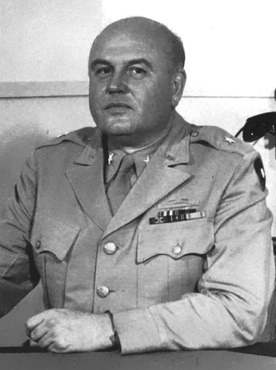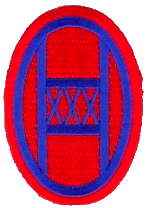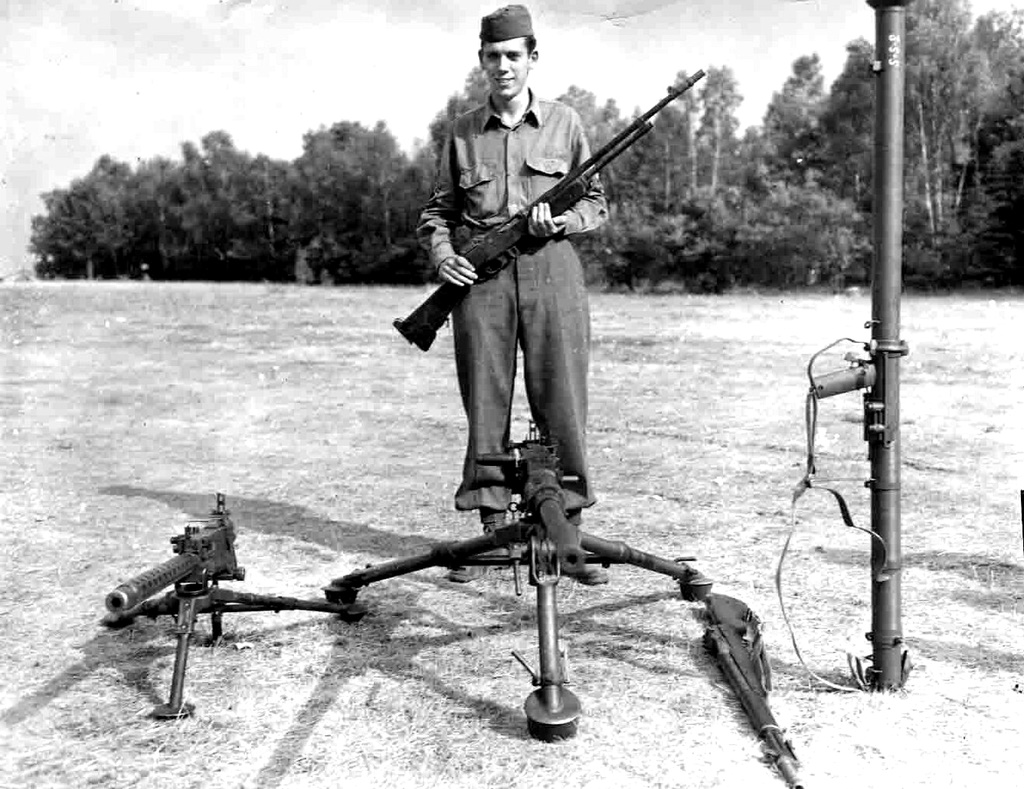Document Source: Bangor Public Library, World War Regimental Histories, 1947, History of the 120th Infantry Regiment, 30th Infantry Division, by the Officers of the Regiment. Original Document 1947, Infantry Press Publication. (Extract of the Original Document)

The 120th Infantry Regiment has a distinguished past and a colorful tradition. From the clay-red soil of North Carolina, throughout the broad area extending from its woods covered mountains to its sloping beaches sprang its different units. The towns which produced the various companies are as follows:
1/120 Battalion Headquarters Company – Oxford
Able Company – Burlington
Baker Company – Warrenton
Charlie Company – Henderson
Dog Company – Durham
2/120 Battalion Headquarters Company – Albemarle
Easy Company – Concord
Fox Company – Charlotte
George Company – Winston-Salem
How Company – Waynesville
3/120 Battalion Headquarters Company – Asheboro
Item Company – Wilmington
Kingh Company – Shelby
Love Company – Parkton
Mike Company – Wilson
Regimental Headquarters – Reidsville
Medical Detachment – Graham
Service Company – Raleigh
As early as the Revolutionary days, some of these companies were making military history. Some historians believe Love Co to be the oldest company in the United States Army. Another of the oldest of the group was Fox Co, originally called the Mecklenburg County Minute Men. During the historic Battle of King’s Mountain, this group so consistently and effectively dismayed the forces of Lord Cornwallis, that the British General was heard to refer to the resistance offered by this unit as ‘a veritable hornets’ nest’. Today, on the Regimental colors, the acute observer will note a stalk of goldenrod, the North Carolina state Hower, near a swarm of hornets and their nest. A recent opponent paid a like compliment when he called men of the Regiment, President Roosevelt’s Storm Troopers. The other companies were all organized during the nineteenth century, but they were not formed into a regiment until 1916 when, as the North Carolina Infantry, they served on the Mexican Border. In September 1917, the Regiment was first assigned to the Division with which it has served in two great wars – the 30th (Old Hickory) Infantry Division which was comprised also of units from South Carolina, Georgia, and Tennessee.
The 120th Infantry first landed in France in June 1918, twenty-six years and a day before the Great Invasion of Normandy. Its members were among the first American troops to enter Belgium, although they did not enter fighting as in this war, being used to replace other troops which occupied the stabilized defense line in the sector of the British Second Army. In September, the Regiment was assigned first to the British Third and shortly thereafter to the British Fourth Army. It was as part of the latter unit that on September 29, 1918, the 120 made the celebrated assault upon the formidable Hindenburg Line, near Bellicourt (France), between Cambrai (France) and Saint-Quentin (France). The drive was successful in smashing the German defenses and precipitated the end of the war. A month later the Regiment moved to a rest area, and there its men received news of the Armistice. After six months overseas, the outfit had gained an enviable reputation for having never retreated and had earned three streamers for the Regimental Colors: France, the Ypres-Lys Campaign, and the Somme Offensive. From the Portuguese government, the Regiment was honored with the order of Torre-e-Espada (Tower and Sword Cavalier).
The 120 returned to the States in April 1919. Following World War I, the Regiment was inactivated for two years. In 1921 it was reorganized, again on a National Guard basis, and received Federal recognition. For eighteen years it trained faithfully in regular weekly sessions and yearly practice problems and bivouacs.
 In 1940, a year after the outbreak of the war in Europe, when the first mild warnings against military unpreparedness were being voiced to an unwilling public, the 120th was ordered to Fort Jackson (South Carolina) where it was inducted into active service for what was scheduled to be a year. The response to the call to duty by the ‘Tar Heel’ volunteers was so great that many of the North Carolina companies came to camp overstrength and the excess men of the Regiment was later turned over to other units which needed personnel. In February 1937, the command of the Regiment was given to Col John H. Manning, who had been an executive officer under the previous commander, Col Don E. Scott.
In 1940, a year after the outbreak of the war in Europe, when the first mild warnings against military unpreparedness were being voiced to an unwilling public, the 120th was ordered to Fort Jackson (South Carolina) where it was inducted into active service for what was scheduled to be a year. The response to the call to duty by the ‘Tar Heel’ volunteers was so great that many of the North Carolina companies came to camp overstrength and the excess men of the Regiment was later turned over to other units which needed personnel. In February 1937, the command of the Regiment was given to Col John H. Manning, who had been an executive officer under the previous commander, Col Don E. Scott.
It was Col Manning who brought the Regiment to Jackson, and in his charge was the extensive course of training that the Regiment was to take there. It had become clear that Col Manning had not only the ability to build a strong well-knit unit but also the capacity to make men extraordinarily fond of him. Under him, the traditional informal title applied to any regimental commander ‘The Old Man’, became a term of endearment and profound respect.
 Under him, the Regiment was readily molded into an efficient organization ready for battle whenever it was needed. When the appointed year of training at Fort Jackson was completed, a period during which the 120th had participated in maneuvers in Tennessee and the Carolinas, the outrage at Pearl Harbor shook the nation. The men of the Regiment preparing to return to civilian life as scheduled learned that all discharges were canceled and that they were in uniform to stay. The 120th was alerted as one of the units capable of moving into instant action should the homeland be imperiled by the enemy at that time.
Under him, the Regiment was readily molded into an efficient organization ready for battle whenever it was needed. When the appointed year of training at Fort Jackson was completed, a period during which the 120th had participated in maneuvers in Tennessee and the Carolinas, the outrage at Pearl Harbor shook the nation. The men of the Regiment preparing to return to civilian life as scheduled learned that all discharges were canceled and that they were in uniform to stay. The 120th was alerted as one of the units capable of moving into instant action should the homeland be imperiled by the enemy at that time.
With the year 1942 came a rejuvenated and ambitious program of reorganization and modernization within the United States Army. The 120th Infantry, still stationed at Fort Jackson, was subjected to a multiplicity of changes, which included the addition of Cannon and Antitank Companies within the Regiment. The Division organization was changed from the square, or four-regiment type, to the triangular of three regiments. The intensive training made exemplary show troops of the 120th Infantry, and it was reviewed by leading dignitaries of many nations. But in the fall of 1942, the first real change in the personnel of the 120th took place. Because of the demand for competent leaders so pressingly needed elsewhere in that crucial year, Col Manning was taken from the Regiment. Furthermore, the 120th Infantry was called upon to supply officers and men for the 118th Infantry which was given an overseas mission; it gave men and officers to activate a new brother regiment, the 119th Infantry; and it sent more personnel to the 117th Infantry on assignment as school troops at Fort Benning (Georgia). In addition, other commissioned and enlisted cadres were drawn from the 120th to help activate new divisions.
Basic at Camp Blanding
The 120th received replacements and once again began the arduous work of training. Under a new energetic Regimental commander, Col Hammond D. Birks, the 120th moved to Camp Blanding (Florida), near Gainesville, in October 1942. Blanding was the cradle of the highly efficient unit which distinguished itself consistently during its days of training and was later to prove itself magnificent in combat. After seven months of rigid training emphasizing particularly marksmanship and physical fitness, the Regiment moved to a tent city on the outskirts of Camp Forrest (Tennessee) and for three months underwent 30th Division maneuvers, closely followed in September 1943, by Second Army maneuvers. In the latter, where the 30th maneuvered with and against the 94th Infantry Division and the 98th Infantry Divisions as well as the 12th Armored Division, the 120th Regiment established a remarkably outstanding record. One battalion marched thirty-six miles in pouring rain and maintained contact with the ‘enemy’ throughout that night, while on the same day, the other two battalions marched thirty miles and waged mock battle, all with a maximum of coordination.
Overseas Movment
In November 1943, following the completion of maneuvers, the 30-ID moved to Camp Atterbury (Indiana), where for four months the men of the Regiment trained in preparation for overseas movement. Then, with complete equipment and in full strength, the 120th moved to the staging area, Camp Myles Standish (Massachusetts) where for a week the men were given final processing. On February 12, the Regiment sailed from Boston on the SS Argentina, headed for England and for a long hazardous trip through Europe which was to last eighteen eventful months. Carrying all the units which comprised the 120th Regimental Combat Team, including the 230th Field Artillery Battalion, Charlie Co of the 105th Engineer Battalion, and Charlie Co of the 105th Medical Battalion, the ship was part of one of the largest convoys in history. In twelve days the troops were debarking at Gourock, near Glasgow (Scotland), which became the established point for troop arrival in the European Theater of Operations until many months after the invasion of the Continent. Trains carried the units of the Division of the length of England to the southern coasts where, at the seaside resort of Bognar Regis between Portsmouth and Southampton, the 120-IR established its headquarters. Then followed more training, including one week of tank-infantry problems near Warminster. As the gigantic D-Day approached, however, orders came that all coastal towns must be evacuated to allow room for supplies and troops about to assail the enemy in Normandy. On April 3, the Regiment moved north to the vicinity of Woodland Park, Buckinghamshire, where the battalions were assigned to separate areas. Both FM Bernard Montgomery and Gen Dwight D. Eisenhower inspected the Regiment during its training there.
Leaders
About to enter combat, the officers of the 120-IR worked hard to shape their units into effective and fast-driving teams. The former Regimental Executive, Lt Col Garvin B. Farris, had become ill shortly after arriving in England, and his place had been taken by Lt Col Peter O. Ward, formerly 3d Battalion commander. Lt Col Henry C. Crumley, who commanded the 2d Battalion during most of the training period, was also evacuated to a hospital. Just prior to entering combat, the battalion commanders of the 120-IR were: Lt Col Hugh I. Mainord, 1/120; Lt Col William S. Bradford, 2/120 and Lt Col Paul W. McCollum, 3/120. The staff included Lt John J. Eberhardt, S-1; Capt Ezekiel L. Glazier, S-2; Maj Leland L. Lambe, S-3; and Maj James J. Bynum, S-4. CWO James B. Lyles exemplified the spirit of the 120th during his long service as Regimental Sergeant Major and later as Assistant Adjutant.
On the 1st of June 1944, speaking to his men about what lay ahead for the 120-IR, Col Birks said: This is a great athletic contest. We are supposed to be the greatest athletes in the world. We must live up to our reputation. With all our minor troubles we have been successful in everything that we have done. We are the outstanding and most trusted, infantry regiment in this Division. For the future, I ask God to bless you, and that you come through the ordeal ahead, safe and sound, with your head high in the pride of victory. For myself, I don’t ask God for any special favor to protect me from death or wounds, for instance, but I do ask Him, with my whole heart and soul, to give me the moral, physical, and mental courage and strength to do my duty to the utmost.
December 1944
December 1944, began with bright prospects, and many men in the 120-IR could envision German surrender before the end of the year. Our forces had breached the Siegfried Line, and with the constant pressure of the Russians on the eastern boundaries of the Reich, many GIs felt that Germany must be on the verge of collapse. For those who coddled themselves into believing this, the month was to be one of cruel disappointment and rough living. The Regimental CP had been established since the taking of Erberich in November in a chateau-like farmhouse that had belonged to some wealthy citizen of Langweiler (Germany). The battalions were assembled in towns in the vicinity: the 1/120 at Erberich, the 2/120 at Lohn, and the 3/120 at Broichweiden. There, the troops had set up in houses and were recuperating from the successful drive from Birk to the banks of the Inde River, culminated by the spectacular and successful night attack on Altdorf. The Begiment’s forward positions in the vicinity of Altdorf were occupied by the 17-CRS, attached, which completed its occupation by 0042 on the first day of the month. The Division Recreation Area at Kerkrade (Holland), formerly the Bolduc School, known as ‘The Monastery’ with its Red Cross coffee and doughnuts, its GIs and USO shows, and its passes to Kerkrade provided a welcome rest for the deserving men of the 120-IR this month. The 3/120 moved there on December 2, for two days, while the 2/120 moved back from Lohn to Broichweiden. Two days later, the 2/120 was trucked to ‘The Monastery’, and the 1/120 moved to Broichweiden, while the 3/120 replaced the 1/120 at Erberich. Another rotation on December 4, shifted the 2/120 back to Broichweiden, the 1/120 to the Recreation Area. Two days later the 1/120 returned to Broichweiden.
Training in the Combat Area
The battalions which were not in the Recreation Arca conducted a daily training schedule, and from December 6 to December 12, all the troops had regular periods of instruction and practical work. The Regiment had found in the recent campaign that tank-infantry teams could do extraordinarily successful work. Accordingly, much time was given to training the infantrymen to ride the M-4s and to dismount in time to give the maximum all-around protection. The account also was taken of the fact that in the defense of his country, the German had consistently set up his lines in and around towns and villages, like Euchen and Lohn. Troops were, therefore, taught the lessons learned through battle experience in those places. And finally, a third stress was laid on night tactics; the operation at Altdorf had proved that the 120-IR could make a night attack spell ruin for the Krauts. Training also included woods fighting, although the Regiment little realized at the time how important this form of battle was to be in its later operations. All weapons were fired, from the pistol to the 57-MM AT gun. Athletics were organized, and church services were held.
Attack on Viehhofen
At 0240, on December 13, Love Co commanded by 1/Lt George R. Reeves, began a small campaign of its own. It moved from Erberich to a position a half mile southeast of Altdorf and across the Inde; there it went into position facing the northeast while the 414-IR attacked the town of Schophoven. Love Co protected the left flank of the attacking forces until Schophoven fell to the 414-IR in the afternoon. Viehhofen was a hamlet due west of Schophoven and was known to contain a small force of the enemy. The Germans had organized their defense to opposing an attack from the west, from the north of Altdorf across the river. At 1830, Love Co, with its Line of Departure already across the Inde, rose from the south to surprise the enemy on his weak left flank. With no difficulty, Lt Reeves and his company captured the town, the ground around it, and sixteen soldiers of the Wehrmacht. Five men of Love Co were wounded during the attack. It was impossible to use vehicles in crossing the open ground, but the imperative need to have aid for the men was recognized. Men in the Weapons Platoon volunteered to carry the wounded across the muddy ground to Inden and grabbed up doors, in lieu of litters, on which to place the casualties. The three miles to Inden took time and selfless effort, but in the end, five lives were saved. The night before the attack a listening post had been set up between Altdorf and Viehhofen. T/Sgt John Hescigno accompanied the men of the post on their way from Erberich through Inden; there an incoming shell wounded him severely in the leg. Crippled and in pain, he continued with his mission and dispatched the men to their post at the proper time, as directed. T/Sgt Hescigno joined his company in the attack and, after the objective had been taken, helped evacuate the wounded. Only then did he submit himself to be cared for by the medics. Of such devotion to duty is the success of the 120-IR or any regiment made.

























